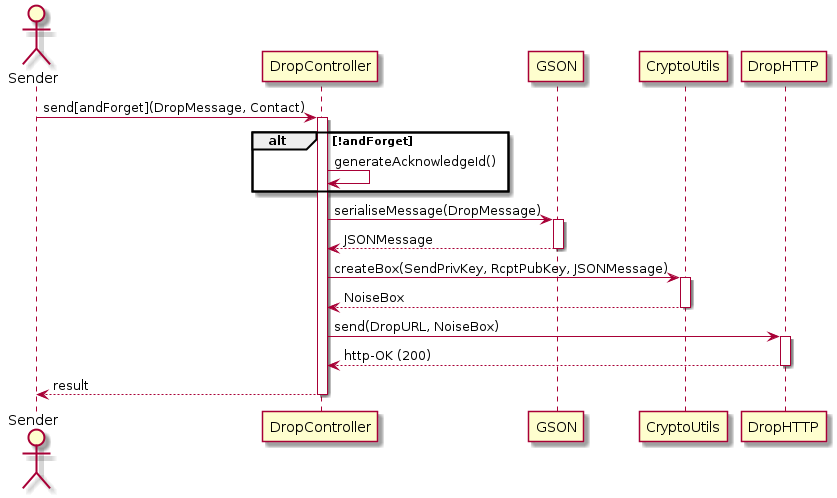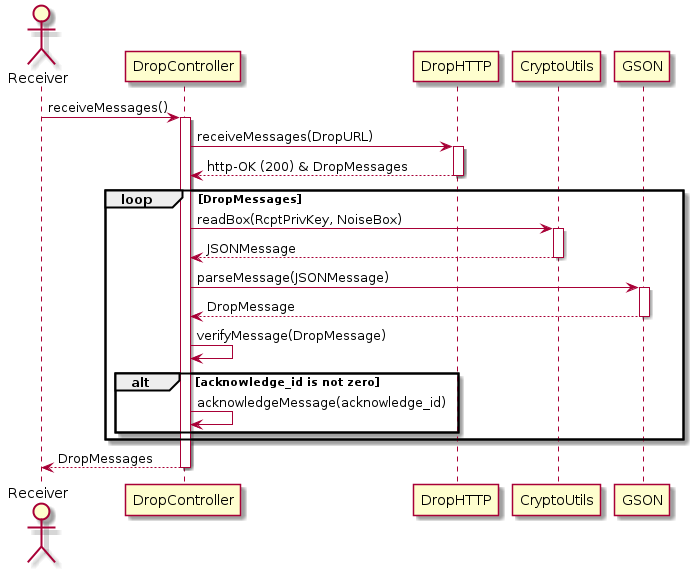Drop Specification
Abstract
A protocol to write and read from a Qabel drop server.
Protocol
Data types are defined below and here.
Structure of the Endpoint URL
The URL to access a drop on a qabel drop server can be split into four parts, protocol, server address (incl. port), service path and drop ID:
- Protocol is http or https.
- Server address is an IP (IPv4 or IPv6) or a DNS host address. For non-standard ports, the port number gets appended.
- The service path is the base path of the server (e.g. URL of the PHP script or mapping in the reverse proxy). The path includes the leading slash (“/”).
- a valid URL of a drop always contains the drop ID.
dropurl ::= protocol "://" serviceaddress servicepath "/" dropid
- protocol ::= “https” | “http”
- serveraddress ::= IPv4 | IPv6 | DNSName
- serverport ::= “1” - “65535”
- serviceaddress ::= serveraddress ( “:” serverport ) ?
- servicepath ::= “/” [ URLChars, “/” ] *
- friendlybase64char ::= [ “A” - “Z”, “a” - “z”, “0” - “9”, “-“, “_” ]
- dropid ::= <43>*friendlybase64char
Note that DNSName should not be a relative DNS name, but an absolute
(also called fully-qualified) name, (cf. RFC 1034 § 3.1 for the
difference) since this is an URL. This also means that simple
hostnames as in http://horst/... are not valid drop
URLs. localhost is a special case accepted by most systems, and is
intended solely for testing. It should not be used in any production
system.
Example:
http://d.example:1234/tools/drop/1234567890123456789012345678901234567890123
http://some-machine.local:1234/1234567890123456789012345678901234567890123
Invalid examples:
http://some-machine/1234567890123456789012345678901234567890123 (not a qualified name and not localhost)
http://d.example:1234/123456789012 (incorrect length of drop ID)
http://d.example:1234/tools/drop/1234567890123456789012345678901234567890123/ (trailing slash)
http://d.example:1234/tools/drop1234567890123456789012345678901234567890123 (missing separator between servicepath and dropid)
Drop IDs
Drop URLs are identified by a 256 bit (32 byte) value as ID. Coding is “URL friendly Base64”. See RFC 4648 “Base 64 Encoding with URL and Filename Safe Alphabet”.
The client has a setting to trade off anonymity against traffic. Let the setting be a percentage value p (0 < p <= 1) which expresses how much of the available drop box range should be used. Then the drop id is calculated the following:
id := random_pick_from_range(0, (2^id_length * p) - 1)
The corner cases are:
- p=1: The complete range of drop ids is used, thus collisions are unlikely.
- p -> 0: Very few drop ids are used, collisions are very likely and drop boxes are heavily used.
Communication with Server
Available are the REST methods GET, HEAD and POST, and one-way WebSockets.
To reduce Spam and Denial of Service attacks a proof of work protocol could additionally be implemented (see Proof of Work)
Both GET and HEAD return a Last-Modified and a X-Qabel-Latest header. X-Qabel-Latest is an opaque value (treat it like an ETag) that orders drops. This value can be used with X-Qabel-New-Since for race-free and precise “new since last request” semantics, unlike Last-Modified and If-Modified-Since, which only provide one second resolution (RFC 2616 sections 3.3.1 and 14.29).
GET
The GET method asks for a complete drop or a defined part of the newest entries.
Return values
| HTTP status code | reason |
|---|---|
| 400 | the drop ID is missing or invalid |
| 204 | the drop is empty |
| 200 | the drop contains messages |
Optional with If-Modified-Since/X-Qabel-New-Since header:
| HTTP status code | reason |
|---|---|
| 204 | the drop is empty |
| 304 | the drop doesn’t contain any new messages |
| 200 | the drop contains new messages |
The HTTP body gets returned as MIME multipart of the single messages.
MIME Multipart: The ‘Content-Type’ is ‘multipart/mixed’. Each individual part has a ‘Content-Type’ of ‘application/octet-stream’ and a ‘Date’ header. The messages are uncoded 8-bit streams.
HEAD
The HEAD method determines if a drop is filled or if a new message has arrived.
Return values
| HTTP status code | reason |
|---|---|
| 400 | drop ID is missing or invalid |
| 204 | drop is empty. |
| 200 | drop contains messages |
Optional with If-Modified-Since/X-Qabel-New-Since header:
| HTTP status code | reason |
|---|---|
| 204 | drop is empty |
| 304 | drop doesn’t contain any new messages |
| 200 | drop contains new messages |
No HTTP body gets returned.
POST
With the POST method a new message gets added to a drop. The drop can already contain messages or be empty/unused.
Return values
| HTTP status code | reason |
|---|---|
| 200 | message was added |
| 400 | drop ID is missing or invalid or no message has been submitted at all or the Authorization header is missing or wrong |
| 413 | message exceeds the maximum size |
The message has to be transmitted as HTTP body. The Authorization header has to be “Client Qabel”. The HTTP body is an encoded 8-bit stream. No HTTP body gets returned.
Push / WebSockets
A drop server also supports WebSockets. While it would be possible to
implement these on the exact same endpoint path as the regular REST
methods (requests can be distinguished by their Connection: Upgrade
and Sec-WebSocket-Key headers), we choose not to as most frameworks
presuppose path-based routing, and cannot support header-based routing
out-of-the-box.
Therefore WebSockets are available at <endpoint path>/ws (note the
absence of a trailing slash, just like the REST endpoint). The WebSocket
subprotocol is v0.ws.drop.qabel.de.
The server ignores messages sent by the client.
The server sends one binary frame for each drop message received. It does not send drop messages that were received before the WebSocket connection was opened.
Each frame is divided into a header and the actual drop
message. Header and drop message are separated by the first two new
lines (0x0a 0x0a) in the frame.
The header consists of UTF-8 encoded HTTP headers which can be sent to
the REST API to receive all drop messages since this drop. In other
words, these are the Last-Modified and X-Qabel-Latest headers that
would be sent if the drop message was the last (most recent) drop
message in a GET response of the REST API (however, the exact layout
is not guaranteed and clients should not make unsafe assumptions about
the layout of these headers. Instead, use standard HTTP header parsing
methods).
To avoid race conditions in opening a WebSocket connection clients should follow this recipe:
- Open the WebSocket connection
- Poll the REST API for changes once (using
Last-ModifiedorX-Qabel-Latestheaders stored from previous interactions, eg. the last HEAD or GET, but also from WebSocket frame headers.)
This way a client won’t miss drop messages received by the server during opening the WebSocket connection, or between connections, if the client mainly relies on WebSockets.
Messages
Lifetime
[To be defined] The maximum lifetime of a drop message is 1 week. If the quota for drop messages is full, the globally oldest message of a dropserver will be deleted.
History / Persistence
[To be defined] The core will handle the drop history but this functionality is not yet defined. Messages which are needed across all devices of an identity must be shared across all devices. The exact way has to be defined.
Size
The total size of a message depends on the used transport format. A drop server must reject messages that are larger than the size of the largest supported transport format.
Transport format
The following section defines the protocol data unit (PDU) of the Qabel Drop protocol. This PDU is transmitted as body of a HTTP request/response.
The PDU starts with a version byte to indicate the version of PDU format.
PDU Version 0
| Message part | Field | Description | Length (in Bytes) |
|---|---|---|---|
| Header (unencrypted) | Version | Version of the Qabel drop message format (here 0) | 1 |
| Body | Noise box | Drop message encrypted into a Noise box | variable |
Header
The header is unencrypted and consists of a one-byte version number indicating the version of the binary Qabel Drop message.
Body
Encryption
Drop messages are encrypted into Noise boxes.
Format [To be reviewed]
A message is packed into JSON containing the following fields:
| Key | Description |
|---|---|
| version | This key describes the version of the Qabel Drop Message protocol. |
| time_stamp | Date of message generation. |
| acknowledge_id | Acknowledge ID for acknowledging this message |
| sender | Sender’s public key. |
| receiver | Receiver’s public key. |
| model_object | The name of the model object that handles this message. |
| data | The payload of the message. |
drop_message = "{"
'version' : INT,
'time_stamp' : LONG,
'acknowledge_id': STR,
'sender' : KEY,
'receiver' : KEY,
'model_object' : STR,
'data' : { ... }
"}"
Acknowledging
The drop client automatically acknowledges each incoming drop message.
In order to acknowledge message N, the client generates a drop messages where
acknowledge_id is N. The data field of an acknowledge message is undefined.
Messages with the acknowledge_id set to 0 (zero) are not acknowledged.
Send a Drop Message
Task
Alice sends a drop message to Bob’s drop ID.
Prerequisites
- Bob is contact of Alice
- Alice knows Bob’s drop URL and public key
Process
- Client encrypts the drop message with Bob’s public key in a noise box
- Client sends a POST request with the encrypted drop message to Alice’ drop URL
- Server processes the drop message
- If message fulfills the requirements
- Server stores the drop message in the requested drop ID
- Server responses with the HTTP status code 200
- Else
- Server responses with a HTTP status code 4xx (see above)
- Client retries submitting the drop message
- If message fulfills the requirements
Receive Drop Messages
Task
Bob receives drop messages from his drop ID. Therefor he only requests new messages which arrived since his last request.
Prerequisites
- Bob has his drop URL and private key
Process
- Client sends a GET request to the drop URL with a if-modified-since header including the timestamp of the last request
- Server processes the GET request
- If new messages arrived
- Server responses the new drop messages with the HTTP status code 200
- Client tries to decrypt the drop messages with Bob’s private key
- The successful decrypted messages are processed
- If the sender requested an acknowledgment, the message is acknowledged by sending a new drop message (see Acknowledging)
- All other messages are discarded
- The successful decrypted messages are processed
- Else
- Server responses with a HTTP status code x04 (see above)
- If new messages arrived
Sequence diagrams
Send message:

Receive messages:
